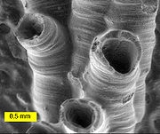
Hederellid
Encyclopedia
Hederellids are extinct colonial animal
s with calcitic tubular branching exoskeleton
s. They range from the Silurian
to the Permian
and were most common in the Devonian
period. They are more properly known as "hederelloids" because they were originally defined as a suborder by Bassler (1939), who described about 130 species. Although they have traditionally been considered bryozoans, they are clearly not because of their branching patterns, lack of an astogenetic gradient, skeletal microstructure, and wide range in tube diameters (Wilson and Taylor, 2001). Work continues on assessing the true affinities of hederelloids, but they appear to be most closely related to phoronid
s and other lophophorates (Taylor and Wilson, 2008; Taylor et al., 2010).
Animal
Animals are a major group of multicellular, eukaryotic organisms of the kingdom Animalia or Metazoa. Their body plan eventually becomes fixed as they develop, although some undergo a process of metamorphosis later on in their life. Most animals are motile, meaning they can move spontaneously and...
s with calcitic tubular branching exoskeleton
Exoskeleton
An exoskeleton is the external skeleton that supports and protects an animal's body, in contrast to the internal skeleton of, for example, a human. In popular usage, some of the larger kinds of exoskeletons are known as "shells". Examples of exoskeleton animals include insects such as grasshoppers...
s. They range from the Silurian
Silurian
The Silurian is a geologic period and system that extends from the end of the Ordovician Period, about 443.7 ± 1.5 Mya , to the beginning of the Devonian Period, about 416.0 ± 2.8 Mya . As with other geologic periods, the rock beds that define the period's start and end are well identified, but the...
to the Permian
Permian
The PermianThe term "Permian" was introduced into geology in 1841 by Sir Sir R. I. Murchison, president of the Geological Society of London, who identified typical strata in extensive Russian explorations undertaken with Edouard de Verneuil; Murchison asserted in 1841 that he named his "Permian...
and were most common in the Devonian
Devonian
The Devonian is a geologic period and system of the Paleozoic Era spanning from the end of the Silurian Period, about 416.0 ± 2.8 Mya , to the beginning of the Carboniferous Period, about 359.2 ± 2.5 Mya...
period. They are more properly known as "hederelloids" because they were originally defined as a suborder by Bassler (1939), who described about 130 species. Although they have traditionally been considered bryozoans, they are clearly not because of their branching patterns, lack of an astogenetic gradient, skeletal microstructure, and wide range in tube diameters (Wilson and Taylor, 2001). Work continues on assessing the true affinities of hederelloids, but they appear to be most closely related to phoronid
Phoronid
Phoronids are a phylum of marine animals that filter-feed with a lophophore , and build upright tubes of chitin to support and protect their soft bodies. They live in all the oceans and seas including the Arctic Ocean but excluding the Antarctic Ocean, and between the intertidal zone and about...
s and other lophophorates (Taylor and Wilson, 2008; Taylor et al., 2010).
Classification
- Family Hederellidae
- Genus Diversipora
- Genus Hederella
- Family Reptariidae
- Genus Cystoporella
- Genus HederopsisHederopsisHederopsis is an extinct genus of the enigmatic hederellids....
- Genus Hernodia

